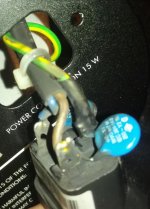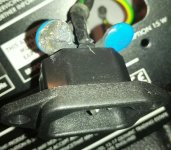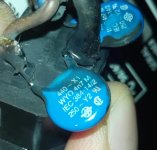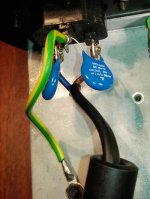Hi
Not having much luck with my X-Ponents at the moment. My Tuner went pop! Opened it up to find these, one of which looks like it blew itself apart. Just inside the case behind IEC socket.
None of the 4 internal fuses blew but the one on the power cord plug did.
I'm sure I can solder new ones in (ceramic caps? please correct me if I'm wrong) but what are they for? One connects L to earth and the other connects N to earth so it looks to me that L & N are connected by two of these in series before having anything to do with the tuner innards.
440~X1 WYO 4n7 M IEC 384-14/2 250~Y2
Above is all the information I found printed on these components that I could see after cleaning the soot off. Are these easy to get hold of without having to buy 1000 or so?
Not having much luck with my X-Ponents at the moment. My Tuner went pop! Opened it up to find these, one of which looks like it blew itself apart. Just inside the case behind IEC socket.
None of the 4 internal fuses blew but the one on the power cord plug did.
I'm sure I can solder new ones in (ceramic caps? please correct me if I'm wrong) but what are they for? One connects L to earth and the other connects N to earth so it looks to me that L & N are connected by two of these in series before having anything to do with the tuner innards.
440~X1 WYO 4n7 M IEC 384-14/2 250~Y2
Above is all the information I found printed on these components that I could see after cleaning the soot off. Are these easy to get hold of without having to buy 1000 or so?
Attachments
Last edited:
These are ceramic disc safety capacitors. Information available here:
Ceramic Disc Safety Capacitors - Vishay | Mouser United Kingdom
Ceramic Disc Safety Capacitors - Vishay | Mouser United Kingdom
Thanks for the link Galu, just had a read. So these have probably just saved my tuner then?
Could a cat brushing past the plug have caused the connection to arc and cause this?
Could a cat brushing past the plug have caused the connection to arc and cause this?
I suggest you remove the failed capacitors and replace the fuse in your power cord plug. Hopefully, this will return your tuner to working order. If so, you can then replace each anti-interference capacitor with one like this:
Ceramic capacitor CK 4,7n/440/250V X1/Y2 WYO RM7,5 20% VISHAY | GM electronic COM
I don't know why the safety capacitors failed, maybe someone else will comment. Perhaps a power surge was responsible. I certainly wouldn't blame the cat!
Ceramic capacitor CK 4,7n/440/250V X1/Y2 WYO RM7,5 20% VISHAY | GM electronic COM
I don't know why the safety capacitors failed, maybe someone else will comment. Perhaps a power surge was responsible. I certainly wouldn't blame the cat!
Found this (postage is free) am I wrong in thinking this is the same item?
WYO472MCMCF0KR | Vishay Single Layer Ceramic Capacitor SLCC 4.7nF 400V ac ±20% Y5U Dielectric WYO Series Series Through Hole | RS Components
Thanks Galu.
P.S.
Don't worry about the cat, she got a bit of a fright as it went pop and she ran away from that area, curled up sleeping now.
WYO472MCMCF0KR | Vishay Single Layer Ceramic Capacitor SLCC 4.7nF 400V ac ±20% Y5U Dielectric WYO Series Series Through Hole | RS Components
Thanks Galu.
P.S.
Don't worry about the cat, she got a bit of a fright as it went pop and she ran away from that area, curled up sleeping now.
Yes, that is the same item. The X1/Y2 designation shows it to be a safety capacitor. Thanks for the confirmation DF96.
For your information: The word 'safety' refers to the fact that it is safe to place this particular capacitor across the live and earth of an ac power supply.
The capacitors do not protect your tuner from fault current in the way that fuses do, as the operating current does not flow through the capacitors.
Instead, they bleed high frequency radio interference picked up by the live and neutral leads down to earth i.e. they are interference suppression capacitors.
It is safe to operate your tuner without the capacitors in place, but replace them to ensure interference free operation.
One of your capacitors appears to have spontaneously failed, shorting the live wire to earth and blowing the fuse in your power cord plug.
Please let us know how things go.
For your information: The word 'safety' refers to the fact that it is safe to place this particular capacitor across the live and earth of an ac power supply.
The capacitors do not protect your tuner from fault current in the way that fuses do, as the operating current does not flow through the capacitors.
Instead, they bleed high frequency radio interference picked up by the live and neutral leads down to earth i.e. they are interference suppression capacitors.
It is safe to operate your tuner without the capacitors in place, but replace them to ensure interference free operation.
One of your capacitors appears to have spontaneously failed, shorting the live wire to earth and blowing the fuse in your power cord plug.
Please let us know how things go.
Last edited:
Just for belt and braces, you might want to replace the capacitors with ones that have a Y1 rating rather than Y2, since those are tested to a higher withstand voltage, as they are used to bridge between primary to secondary. They are also available from the usual suppliers. They will probably be somewhat larger than the Y2s, but you appear to have the room for them.
Thanks wrenchone. Unfortunately I have already ordered the Y2 but I will be bearing your advice in mind for the future.
Is this the basis of what is in a mains conditioner? Couldn't be this simple surely, considering what some of those cost.
Nothing to do with that, the caps are merely shunting RF interference to chassis ground. They are small caps, in the range of 1-10 nF. If they get a nasty enough voltage transient, they will blow, which is what happened here.
Not without the cat dying... Probably a large spike/transient on the mains with more energy than the devices could handle. Lightning, nearby induction motor, old fluorescent light fitting....Thanks for the link Galu, just had a read. So these have probably just saved my tuner then?
Could a cat brushing past the plug have caused the connection to arc and cause this?
Just a quick update for anyone interested.
Safety capacitors in place.
I did remove the old ones, replace the plug fuse and turn it on. It worked fine, though when I tried it after adding the new capacitors I thought it sounded better than without.
Of course this could have been anything from placebo effect to atmospherics but it did sound clearer and more spacious to me at the time.
So in conclusion I am very happy my X-Plora is healthy again.
A big thanks to those who gave valuable advice and insight.
Safety capacitors in place.
I did remove the old ones, replace the plug fuse and turn it on. It worked fine, though when I tried it after adding the new capacitors I thought it sounded better than without.
Of course this could have been anything from placebo effect to atmospherics but it did sound clearer and more spacious to me at the time.
So in conclusion I am very happy my X-Plora is healthy again.
A big thanks to those who gave valuable advice and insight.
Attachments
Thanks for the update! Glad to have been of assistance. 🙂
P.S. If you haven't already done it by now, wrap insulating tape around the exposed socket terminals and the bare wire capacitor leads.
You may not be the next person to open the box, so minimise the danger of electric shock.
P.S. If you haven't already done it by now, wrap insulating tape around the exposed socket terminals and the bare wire capacitor leads.
You may not be the next person to open the box, so minimise the danger of electric shock.
Last edited:
Thanks for the update! Glad to have been of assistance. 🙂
P.S. If you haven't already done it by now, wrap insulating tape around the exposed socket terminals and the bare wire capacitor leads.
You may not be the next person to open the box, so minimise the danger of electric shock.
Ok. Thanks. Will do.
- Status
- Not open for further replies.
- Home
- Source & Line
- Analogue Source
- X-Plora Pop is not music




